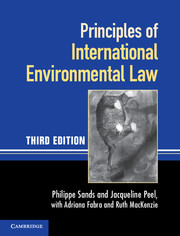Book contents
- Frontmatter
- Contents
- Foreword
- Preface and acknowledgments to the first edition
- Preface and acknowledgments to the second edition
- Preface and acknowledgments to the third edition
- Table of cases
- Table of treaties and other international instruments
- Abbreviations
- Part I The legal and institutional framework
- Part II Principles and rules establishing standards
- 6 General principles and rules
- 7 Atmospheric protection and climate change
- 8 Freshwater resources
- 9 Oceans, seas and marine living resources
- 10 Biological diversity
- 11 Hazardous substances and activities
- 12 Waste
- 13 The polar regions: Antarctica and the Arctic
- Part III Techniques for implementing international principles and rules
- Part IV Linkage of international environmental law and other areas of international law
- Index
- References
8 - Freshwater resources
from Part II - Principles and rules establishing standards
Published online by Cambridge University Press: 05 June 2012
- Frontmatter
- Contents
- Foreword
- Preface and acknowledgments to the first edition
- Preface and acknowledgments to the second edition
- Preface and acknowledgments to the third edition
- Table of cases
- Table of treaties and other international instruments
- Abbreviations
- Part I The legal and institutional framework
- Part II Principles and rules establishing standards
- 6 General principles and rules
- 7 Atmospheric protection and climate change
- 8 Freshwater resources
- 9 Oceans, seas and marine living resources
- 10 Biological diversity
- 11 Hazardous substances and activities
- 12 Waste
- 13 The polar regions: Antarctica and the Arctic
- Part III Techniques for implementing international principles and rules
- Part IV Linkage of international environmental law and other areas of international law
- Index
- References
Summary
INTRODUCTION
A well-developed body of international rules to prevent pollution of freshwater resources (including rivers, lakes, groundwaters and reservoirs) is set forth in bilateral and regional treaties, as well as in the guidelines in non-binding instruments adopted by UNEP, OECD, UNECE and other international organisations, including those in the non-governmental sector, such as the ILA and the IDI. In 1997, under the auspices of the UN, and building on the work of the ILC, a global framework Convention on the Law of Non-Navigational Uses of International Watercourses (1997 Watercourses Convention) was adopted, elements of which are broadly recognised to reflect customary law.
These agreements have emerged for geographical and political reasons: nearly half of the world's river basins are shared by two or more countries, and, although they comprise only about 3 per cent of the volume of water on the planet, they provide the vast majority of the supply used in human activity. Nearly 90 per cent of the total freshwater on the planet is locked into ice caps or glaciers, in the atmosphere or soil, or is deep underground. Thus, the primary source of the planet's available supply of freshwater is in rivers, lakes and reservoirs. Scientists have estimated that the average amount of global runoff (the amount of water that is available for human use after evaporation and infiltration takes place) is between 39,500 km3 and 42,700 km3 a year, of which only around 9,000 km3 is readily accessible to humans, with an additional 3,500 km3 stored in reservoirs. Rainfall varies widely. Heavy rainfall in the Amazon Basin and south and southeast Asia compares with lower rainfall in arid and semi-arid states, which receive only 2 per cent of the world's runoff. Currently, more than 40 per cent of the world's population lives in conditions of water stress, and, if current consumption patterns continue, this figure is estimated to grow to two-thirds of the world's population by 2025. In Africa alone, 75 to 250 million people may be exposed to increased water stress as a result of climate change by 2020.
- Type
- Chapter
- Information
- Principles of International Environmental Law , pp. 303 - 341Publisher: Cambridge University PressPrint publication year: 2012



